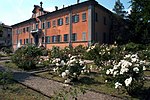For the former Borromeo College in the United States see Saint Mary Seminary and Graduate School of Theology#Borromeo College
The Almo Collegio Borromeo is a private university hall of residence (collegio) in Pavia, region of Lombardy, Italy. It is classified as a "highly qualified Cultural Institute" by the Ministry of Education, Universities and Research and is the oldest such institution remaining in operation in Italy. Together with Collegio Ghislieri – with which a sharp goliardic rivalry has developed during the centuries – it is one of two colleges in Pavia with historical heritage. The building that houses the college was designed by Pellegrino Tibaldi, and overlooks the Ticino, surrounded by landscaped gardens and the Borromeo Gardens. Vasari described it as a "palace of knowledge" ("palazzo per la Sapienza").The college selects students of the University of Pavia through a rigorous public competition based on tests taken annually. The services offered by the college are not limited to food and housing, but rather are focused on providing training in parallel and integrated with the university: for example, CEGA (Center for General and Applied Ethics) is hosted by the college; along with conferences, presentations of books on current affairs, hosting the chair in theology, and offering countless moments of reflection, in addition to the ever-rich artistic and musical seasons in the life of the college. The college also offers various exchange programmes, with institutions such as Corpus Christi College, Cambridge and the College of Saint Benedict and Saint John's University.












